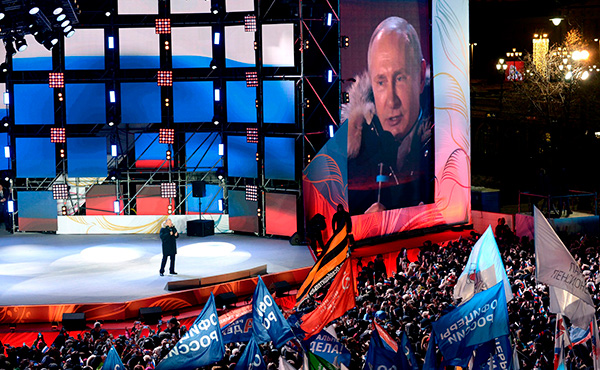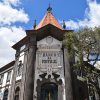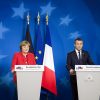Original version in Spanish: Putin después de Putin
Theme
What have been the keys to the victory of Vladimir Putin in the presidential elections held on 18 March? Does the election imply a change in the current Russian political system?
Summary
This analysis complements two previous ARI’s on ‘Putinism’ and Russia-EU relations. It focuses on the keys to Putin’s election victory and on the major outlines of his new mandate. Putin’s victory does not imply a change in Russia’s political landscape, but it does reflect the continuity of ‘Putinism’. However, for everything to stay the same, the country’s economy will have to change.
Analysis
With his victory in the recent Russian presidential election, Vladimir Putin achieved his principal objective: to succeed himself in power. His victory was historic: he won in the first round with 76,6% of the votes cast (by 67.4% of eligible Russian voters). In the face of expected high levels of abstention –reflecting the current political apathy of Russians– citizens were encouraged to vote with gifts and parties at voting stations. Despite claims of illegality by international observers, the Kremlin perceives the results as a strong show of backing for the policies of President Vladimir Putin. Yet the independent electoral supervisory group Golos reported more than 100 irregularities, among them: (1) cast ballots found in some ballot boxes even before the polls had opened; (2) restrictions placed on access for observers to some electoral stations; (3) the suspicious bussing of groups of voters; and (4) obstruction of the web camera views of electoral tables through the use of balloons and other means). Furthermore, the evaluation of the ESCE was that there was no real political competition in these elections.
Keys and strategies of a victory foretold
Putin’s victory rested upon many contributing factors. His electoral strategy consisted of organising the presidential elections to his own measure and taste, displaying open and explicit disdain towards the other seven candidates, boasting of his ‘work well done’ and diverting the attention of public opinion away from the country’s economic problems with the case of the poisoning of double agent, Serguei Skripal, and the supposedly false accusations attributing the murder to the Kremlin –an incident that Putin characterises as nothing more than another sign of the West’s hatred for Russia–. The factors that most influenced the election results include:
- The absence of a solid political opposition, capable of offering a solvent, effective alternative to Putin’s autocratic power.
- The exclusion of all discrepancy (the Kremlin decides who can participate in the elections, drastically reducing the level of political competition).
- The absence of freedom of expression in the communications media.
- The fact that the Russian President ran as an independent candidate to distance himself from the accusations of corruption against the Russia United Party.
- The achievement, undertaken from the seat of power, of a negative consensus among elites and the masses against Western values.
- The recovery of great power status which has implied more confrontation with the West.
- The annexation of Crimea and the wars of the Ukraine and Syria.
- The fact that there does not exist a critical mass of supporters for profound change in Russia.
Furthermore, over the past 18 years during which Putin has been in power (three times as President and once as Prime Minister), the Central State has been re-established, reconciling the traditions of two lost empires –Czarist and Communist– with the support of the Russian Orthodox Church.
The keys
The principal key to Putin’s victory has been the majority-held conviction that the president has recovered great power status for Russia, together with the majority-held reticence for any profound change.
According to the results of an opinion poll undertaken by the prestigious Levada Centre in November 2017, 82% of those surveyed believed that Russia should aspire in the future to great power status, while only 13% claimed that this role was not an appropriate one for Russia. Some 72% already considered Russia to be a great power (in 1999 only 31% believed this, although by 2011 47% did). This patriotic pride is based on the belief that the restoration of the Russian state has been the product of Putin’s foreign policy in the defence of the national interest. Evidence of this is supposedly found in the annexation of Crimea, Russian opposition to the expansion of NATO in the post-Soviet countries, military and political success in Syria and the Middle East and the current confrontation with the West, and especially the US. Despite Western desires, there is no critical mass in Russia that demands radical change, as revealed in another Levada Centre poll in which less than half of those surveyed (42%) believed that it was necessary.
The lack of political competition is another factor of no small importance. Such competition is, in fact, the primary characteristic of free and democratic elections. Alexey Navalni (whom analysts define as ‘the only serious opponent to Putin’) was not able to run in the elections due to the veto on his candidacy imposed by the Electoral Commission because of the corruption accusations against him. It is unlikely that Navalni could have posed a serious electoral challenge to Putin, at least under the current circumstances, but he is nevertheless building a horizontal network via Internet to denounce cases of corruption within the President’s circle. In the end, his call to boycott the election had little effect, suggesting that for now Navalni has support in the large urban zones but not in rural or Asiatic Russia.
The strategies
The central strategy of Vladimir Putin has been to connect with the myth of ‘eternal Russia’ (a Russia conquered by enemies and saved by great leaders) from his position as the President of the Russian Federation.
Putin did not participate in any public debate with the other candidates, but he designed and directed his electoral campaign from his position as president. He chose the date of the election (the 4th anniversary of the annexation of Crimea, called ‘reunification’ in Russia. He changed the date of his traditional address on the State of the Nation (which took place not in December, as in previous years, but rather on 1 March, effectively integrating it into the election campaign). He inundated his country with poster-pictures of himself, while the Kremlin-financed television stations ceaselessly aired documentaries on the personality of Vladimir Putin, his links to the veterans of the Second World War and his increasingly close relationship with the Russian Orthodox Church.
There were two election posters that especially stood out during the campaign. One carried the slogan –Silniy president, silnaya Rossia (‘Strong president, strong Russia’)– superimposed upon Putin’s image, identifying the President with patriotism and suggesting that only a leader like Putin can protect Russia from its numerous enemies. The second is a picture of Putin and a bear, winking at each other in complicity. The bear is the symbol of Russia (as the rooster symbolises France). The bear is known for its strength but also because of a very old and well-known myth among Russians: once upon a time, there was a man whom the other men did not receive in a very friendly manner, offering only bread and salt to welcome him. Ever since, the bear has been sulking and has become aggressive with men, although the bear does not typically attack first. This is a message to the enemies of Russia: if Russia is not treated nicely, the Russians will respond like furious bears.
Since his arrival to power, Vladimir Putin has presented himself as the ‘saviour’ of his people in a dual sense. First, he is presented as the restorer of the centralised state after the failure of the democratic transition in the 1990s. On the other hand, he is also held forth as the morally-cleansing healer (based on his alliance with the Orthodox Church) of the three major national traumas suffered by the Russian people during the 20th century: (1) the Russian Revolution (1917), with which the Czarist Empire was lost; (2) the disintegration of the Soviet Union (1991), which implied the loss of the ‘interior’ (Soviet) and ‘exterior’ (ie, the satellite countries of the Warsaw Pact) Communist empires; and (3) the collapse of the Russian state in 1998.
During the election campaigns of 2000, 2004 and 2012, as a candidate of the United Russia Party, Putin promised the ‘dictatorship of the law’, the ‘liquidation of the oligarchs’, the recovery of public order and security that had been undermined by the chaos of the 1990s and the rebuilding of the centralised state. Such objectives were justified by Putin upon taking office in April 2000 with the following declaration: ‘Russia was founded as a super-centralised state. This is inherent to our genetic code, to our traditions and to the mentality of our people’. During those previous campaigns, the image of Putin was moulded into that of the ‘alfa male’ who flew across the battle lines of Chechnya in a military helicopter, who dived into the Black Sea to retrieve amphoras from the 5th century BC and who guided flocks of cranes while piloting a light aircraft. He was the outdoorsman who rode, bare-chested, on horseback and who would dare to pet the cubs of a Siberian tiger. He was the top athlete who played ice hockey and the judo champion who defeated all his rivals.
The 2018 presidential election campaign, however, revealed a new side to Putin. Kremlin-sponsored television aired numerous documentaries on the ‘religious life’ of the President. One of them focused on Putin’s visit to Vaalam Monastery, the Russian Athos, located on an island in Lake Ladoga in Karelia. There he submerged himself into the icy waters to celebrate the Epiphany ritual. According to the documentary, Vaalam (‘the mirror of Russia’) was destroyed during the Second World War but later restored with the help of the President. As a religious ‘saviour’ he aspires to reconcile two legacies –the USSR’s great power status and the Czarist orthodox imperial tradition– and to connect them with the myth of ‘eternal Russia’ –conquered by the Mongols, Napoleon and Hitler, but then liberated and restored by Ivan III, Alexander II and Stalin, and, long before them, by Alexander Nevski, the saint, warrior and saviour of the Russian kingdom of Kiev in the face of the Swedes and the Germans–. Indeed, Nevski is the model that fits best as Putin’s new avatar.
Putin after Putin
It is clear that Putin’s victory implies no radical change in the Russian political landscape, but rather the mere continuity of ‘Putinism’. According to the Russian Constitution, this is supposed to be his final term.
But as occurred once before (between 2008 and 2012), Putin could exercise power as Prime Minister without changing the constitution. Therefore, during the coming six years it does not appear that the Kremlin will worry itself much with the issue of succession. The political class has no intention of renouncing a hybrid autocracy for a more flexible, democratic system oriented towards a market economy. The principal post-election objective of the Kremlin is to consolidate the unity of the Russian people around his leadership and to appoint loyal technocrats to the government, demonstrating that one does not have to be a friend of the President to be a collaborator. The election results reflect strong support for Kremlin policies, allowing the Russian regime to continue its autocratic behaviour and nationalist policies, and to turn its military success and aggressive foreign policy, along with the anti-Western sentiments of the Russian population, into its central assets. But for everything to stay the same in Russia over the next six years, the Kremlin will need to undertake some substantial economic reforms.
The economic reforms promised by Vladimir Putin in his State of the Nation address have two principal objectives: (1) ‘to preserve national sovereignty’; and (2) to stimulate economic growth. Since 2015 the Kremlin has declared (in military language) that the principal objective of any reform should be to guarantee the economic independence necessary ‘to preserve national sovereignty’ and to defend against both internal and external threats (ie, economic weakness and vulnerability to foreign influence, respectively), thereby facilitating economic growth.
To guarantee such economic independence, the government has passed legislation creating a mechanism to modify the State Budget by adjusting it to the price of oil. The 2017-19 Budget was based on an oil price of US$40/barrel, although it is currently above US$60.
To ‘preserve national sovereignty in the economic sphere’ the government took a first step in this regard by responding to the imposition of economic sanctions by the West in 2014 with the creation of the Government Commission for Import Substitution. The programme aspires to reduce Russian dependence on foreign technology by supporting domestic production. In 2015, 570 investment plans were presented for import substitution projects in 19 different sectors.
In September 2017 the draft bill for the Importation Law was presented to the Duma. It proposed that all state companies seek government approval for any purchase of foreign planes, helicopters and ships. This task will require a titanic effort, given that 90% of the hardware used in Russia, and 70% of the software, is imported. This government strategy erodes competitiveness (by reducing the presence of foreign firms) and places a break on innovation. Nevertheless, protectionism is emerging as the major tool for combatting ‘foreign influence’.
The search for a new strategy to stimulate economic growth has been supported by an official competition between the draft documents of three institutions, each commissioned by Kremlin to elaborate a report on ‘The Economic Security Strategy of the Russian Federation to 2030’:
- The Ministry of Economic Development (MED), directed by the Minister Maxim Oreshkin.
- The Stolypin Club (SC), directed by Boris Titov.
- the Centre for Strategic Research (CSR), whose top figure is the former Minister of Finance, Alexsei Kudrin.
None of the draft documents have been made public, but revelations made in the Russian press –including articles by some members of these respective teams– suggest that the three visions are quite different. In one study, published by ISPI, Philip Hanson details the characteristics of the three proposals.1
The strategic proposal to foment investment in the MED’s ‘target’ scenario is a ritualistic defence of a policy to improve the conditions affecting entrepreneurship and to moderately relax fiscal austerity. A previous version had proposed slowing the growth of real wages to stimulate business, but in the new draft that proposal has been dropped.
The core of the SC plan is the typical demand for improved conditions for business investment and for fiscal and monetary stimulus, while maintaining the government deficit at 3% of GDP (sufficiently modest by Western standards, according to experts, but quite striking for the Russian Ministry of Finance), a constraint that will be financed by foreign loans and a monetary expansion of some 10.5 billion roubles. This plan also includes the restructuring of small and medium-sized company debt. The critics of these proposals argue that while such policies might help stimulate production and growth in the short-run, in the medium and long-run they will inevitably lead to inflation.
The proposals of the CSR are focused on fiscal tightness and the liberalisation of the economy. They involve an increase in state investment in health and education, but also a gradual decline in the budget for ‘unproductive uses’, –an expression of Kudrin’s to refer to military institutions and the silovki–. Such spending would fall from 3.1% to 2.8% of GDP by 2018, and then progressively from 2.3% to 1.8% in 2024. The retirement age would also gradually rise. In addition, there would be: (1) a phased privatisation of state banks and state-owned companies; (2) cuts to state administration; (3) new measures to facilitate business; and (4) judicial reforms to broaden the independence of the courts. Kudrin’s economic plan, without a doubt the most liberal, would imply the equivalent of a remodelling not only of the economy but of the entire political system. It therefore has little possibility of being accepted by Putin, although the President has promised to reduce military spending ‘without ignoring the defence of the country’.
Conclusion
The survival of ‘Putinism’ depends on the continuity of the foreign policy confrontation with the West, the Kremlin’s capacity to control political opposition and civil society unrest and profound structural economic reform. Vladimir Putin has learned from Gorbachov’s failure –one should not undertake reforms that threaten one’s own power, no matter how good they might be for Russia– and therefore it is highly likely that ‘Putinism’ will agonise on as a regime for years without any significant change.
Mira Milosevich-Juaristi
Senior analyst, Elcano Royal Institute | @MiraMilosevich1
Philip Hanson (2018), “Russia’s quest for economic independence”, in Russia 2018. Predictable Elections, Uncertain Future, ISPI, p. 95-117.



